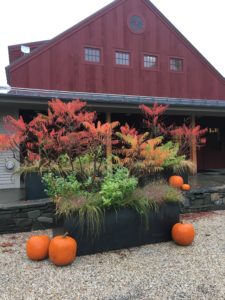Native Plants: Tangible Attributes
By Thomas Christopher
Donna Wiley, the Formal Garden Horticulturist at Mt. Cuba Center, has an answer for the many gardeners who believe that native plants are suited only to naturalistic plantings, that they are too wild and lanky for use in more traditional garden designs. Donna has put in thirty years at Mt. Cuba, a botanical garden in Hockessin, Delaware that’s devoted to the conservation and popularization of native plants. Aside from a lilac allée that dates back to Mt. Cuba’s days as a private estate, virtually all the plants in Donna’s carefully disposed borders and beds are natives. They are, she points out, better for pollinators and more hospitable to wildlife in general than conventional garden plants. And the natives are, in Donna’s handiwork, undeniably beautiful. Still, she recognizes that switching to natives may be intimidating to the owners of more conventional landscapes. That’s why she suggests experimenting first with container plantings.
Well-constructed container plantings dress up any garden, formal or informal. They provide spots of color and interest that can serve as focal points or rhythmic punctuation for a garden display. By putting plants on a pedestal, they also highlight their particular beauties. There are, however, some special aspects to using native plants effectively in containers. But learning how to negotiate these peculiarities is well worth the effort. For they present an education in microcosm about the issues of using natives in any formal garden setting.
One aspect of displaying natives in containers that Donna emphasizes is that the bulk of the native species with which you will be working are perennials. This is distinct contrast to traditional container displays which typically emphasize annual flowers. The annuals, of course, bloom for a protracted season, in some cases virtually all summer. Perennials, on the other hand, have a shorter season of bloom, lasting only a few weeks. This means that when working with natives, you must rely more on the colors and textures of the foliage to provide the containers with visual interest. Because natives tend to be more closely adapted to their habitats than their traditional garden counterparts, it is more important to match the species to the situation in which the container will find itself.
To counteract the tendency of the native species to be lanky and undisciplined in form, Donna recommends working with compact cultivars, clones of the wild plants that have been selected and propagated for their denser, more controlled growth. The use of these so-called “nativars” is somewhat controversial in native plants circles, with purists insisting that they are less beneficial to pollinators than their wilder relatives. They do fit in a container better, however, and Donna’s unscientific observation has been that they still seem attractive to bees, butterflies and others. If, however, you do insist on working with wild-type natives, Donna advises scaling up the containers to accommodate their more expansive growth.
Donna also recommended starting with good sized plants, such those sold in 1-gallon nursery pots. Because most of the herbaceous natives you will be using are perennials, they don’t bulk up as fast as the garden annuals used in conventional container plantings. If you start with small plugs of the native perennials, they are unlikely to achieve a satisfactory size by the end of the growing season.
Finally, because the native plants tend to be closely adapted to specific habitats, it is essential to consult their needs when selecting the plants for a particular container. Many of the traditional garden plants have been selected and bred to tolerate a wide range of conditions, from sun to shade, and spring cool to summer heat. The natives are, as a group, less accommodating and must be matched more carefully to the setting.
These considerations apply equally when you choose to include native plants in the flower garden at large. In this sense, experimenting with native containers is a good school for an expanded use of this group of plants. Even if, though, you do not intend to graduate, you’ll find these native containers a pleasure all by themselves.
Thomas Christopher is the co-author of “Garden Revolution” (Timber Press, 2016) and is a volunteer at Berkshire Botanical Garden. berkshirebotanical.org
Be-a-Better-Gardener is a community service of Berkshire Botanical Garden, one of the nation’s oldest botanical gardens in Stockbridge, MA. Its mission to provide knowledge of gardening and the environment through 25 display gardens and a diverse range of classes informs and inspires thousands of students and visitors on horticultural topics every year. Thomas Christopher is the co-author of Garden Revolution (Timber press, 2016) and is a volunteer at Berkshire Botanical Garden. berkshirebotanical.org.




